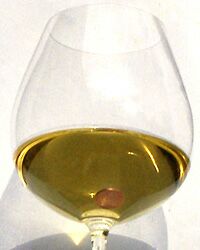|
Stinky wine and the penny trick
This unpleasant aroma, like a whole range of other peculiarly stinky characteristics that occasionally show up in wine - cooked cabbage, rotten eggs, even skunk juice or sewer gas - signals the presence of hydrogen sulfide (H2S), an inorganic compound containing sulfur. Sulfur compounds form naturally in fermenting wine through a process that scientists call "reduction." The exact opposite of oxidation, reduction may occur in wines made under airtight conditions; indeed, some critics theorize that wines kept long-term under screwcaps may be subject to reduction in the cellar because the newfangled high-tech closures might not let enough air in.
Some bad smells in wine are fatal flaws, but sulfury reductive aromas are relatively easy to banish from your wine by an old trick so simple that you might assume it's a myth: Simply drop a clean penny (or any copper-coated coin) into the afflicted wine. (Or, if you worry over-much about where your penny has been, stir your wine with a polished silver spoon.) It's not magic, it's only chemistry: The metal in the coin or spoon reacts with the H2S in the wine, quickly converting it into insoluble (and odorless) copper or silver sulfide. I dropped a handy 1 Euro cent coin into the subject wine last night, and found the rubber-tire aroma was diminished almost immediately and completely gone after 10 or 15 minutes. It's a trick worth remembering ... if you're squeamish, though, make sure you scrub the penny first, or use the silver spoon. There's no point in pillorying the guilty wine, as the condition is temporary and reversible. The sharp-eyed will catch it in due course when I eventually post my tasting report.
One important clarification, by the way: Reductive wine and Hydrogen sulfide and H2S has nothing to do with the much maligned sulfites that prompt warning labels on wines sold in the U.S. and some other countries because of their danger to asthmatics. If you'd like more on that story, see The 30 Second Wine Advisor for
Sept. 9, 2003,
TALK ABOUT WINE ONLINE: If you prefer to comment privately, feel free to send me E-mail at wine@wineloverspage.com. I'll respond personally to the extent that time and volume permit.
PRINT OUT TODAY'S ARTICLE
SUBSCRIBE: Administrivia To subscribe or unsubscribe from The 30 Second Wine Advisor, change your E-mail address, or for any other administrative matters, please use the individualized hotlink found at the end of your E-mail edition. If this is not practical, contact me by E-mail at wine@wineloverspage.com, including the exact E-mail address that you used when you subscribed, so I can find your record. We do not use our E-mail list for any other purpose and will never give or sell your name or E-mail address to anyone. I welcome feedback, suggestions, and ideas for future columns. To contact me, please send E-mail to wine@wineloverspage.com All the wine-tasting reports posted here are consumer-oriented. In order to maintain objectivity and avoid conflicts of interest, I purchase all the wines I rate at my own expense in retail stores and accept no samples, gifts or other gratuities from the wine industry.
Friday, Jan. 20, 2006
|

 Last night, eager to enjoy a favorite Italian white wine from a respected producer, I got an ugly surprise when I put my nose to the glass and found its expected fruit and minerality significantly obscured by an odd, sulfury scent that resembled nothing so much as the aroma of new black-rubber tires.
Last night, eager to enjoy a favorite Italian white wine from a respected producer, I got an ugly surprise when I put my nose to the glass and found its expected fruit and minerality significantly obscured by an odd, sulfury scent that resembled nothing so much as the aroma of new black-rubber tires.



